The Cambridge History of Japan, Vol. 4: Early Modern Japan
Подождите немного. Документ загружается.

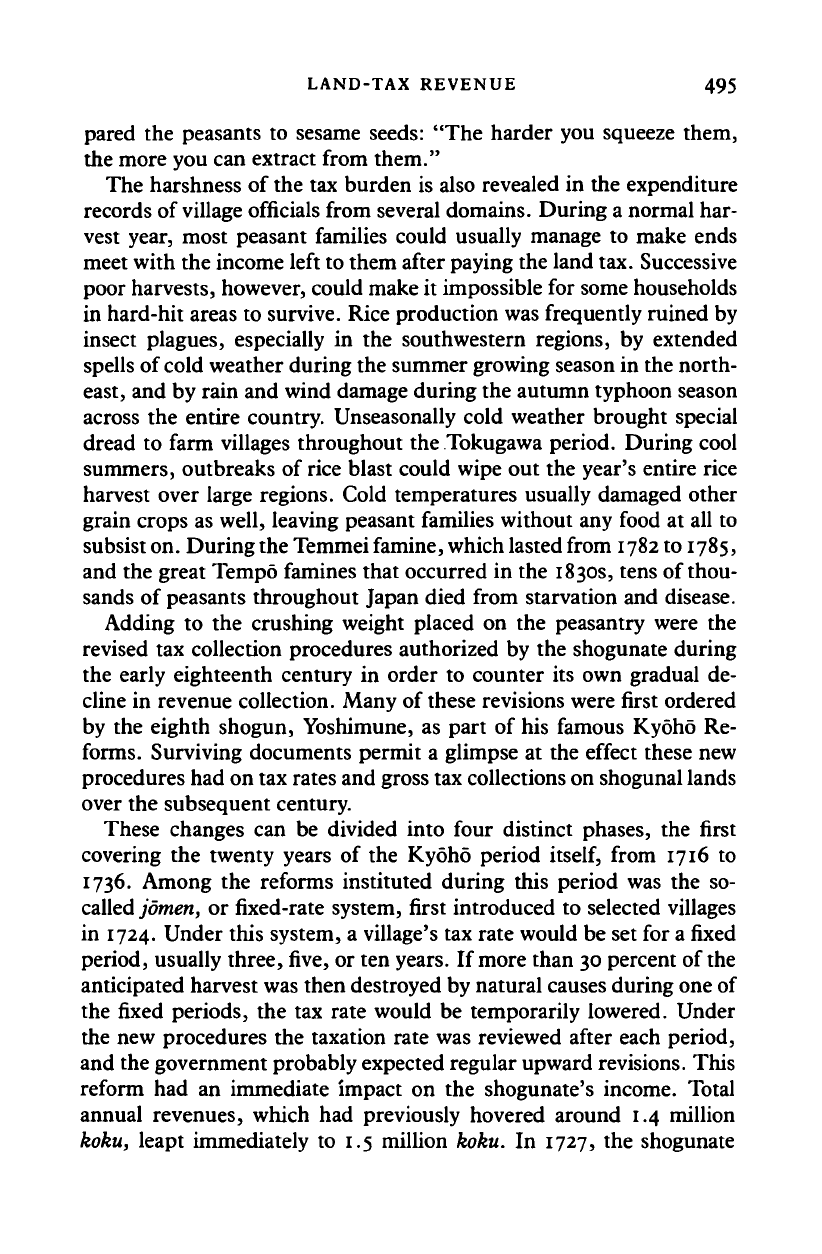
LAND-TAX REVENUE 495
pared the peasants to sesame seeds: "The harder you squeeze them,
the more you can extract from them."
The harshness of the tax burden is also revealed in the expenditure
records of
village
officials from several domains. During a normal har-
vest year, most peasant families could usually manage to make ends
meet with the income left to them after paying the land tax. Successive
poor harvests, however, could make it impossible for some households
in hard-hit areas to survive. Rice production was frequently ruined by
insect plagues, especially in the southwestern regions, by extended
spells of cold weather during the summer growing season in the north-
east, and by rain and wind damage during the autumn typhoon season
across the entire country. Unseasonally cold weather brought special
dread to farm villages throughout the Tokugawa period. During cool
summers, outbreaks of rice blast could wipe out the year's entire rice
harvest over large regions. Cold temperatures usually damaged other
grain crops as well, leaving peasant families without any food at all to
subsist
on.
During the Temmei famine, which lasted from
1782
to 1785,
and the great Tempo famines that occurred in the 1830s, tens of thou-
sands of peasants throughout Japan died from starvation and disease.
Adding to the crushing weight placed on the peasantry were the
revised tax collection procedures authorized by the shogunate during
the early eighteenth century in order to counter its own gradual de-
cline in revenue collection. Many of these revisions were first ordered
by the eighth shogun, Yoshimune, as part of his famous Kyoho Re-
forms.
Surviving documents permit a glimpse at the effect these new
procedures had on tax rates and gross tax collections on shogunal lands
over the subsequent century.
These changes can be divided into four distinct phases, the first
covering the twenty years of the Kyoho period
itself,
from 1716 to
1736.
Among the reforms instituted during this period was the so-
called
jomen,
or fixed-rate system, first introduced to selected villages
in 1724. Under this system, a village's tax rate would be set for a fixed
period, usually three, five, or ten years. If more than 30 percent of the
anticipated harvest was then destroyed by natural causes during one of
the fixed periods, the tax rate would be temporarily lowered. Under
the new procedures the taxation rate was reviewed after each period,
and the government probably expected regular upward revisions. This
reform had an immediate impact on the shogunate's income. Total
annual revenues, which had previously hovered around 1.4 million
koku, leapt immediately to 1.5 million koku. In 1727, the shogunate
Cambridge Histories Online © Cambridge University Press, 2008
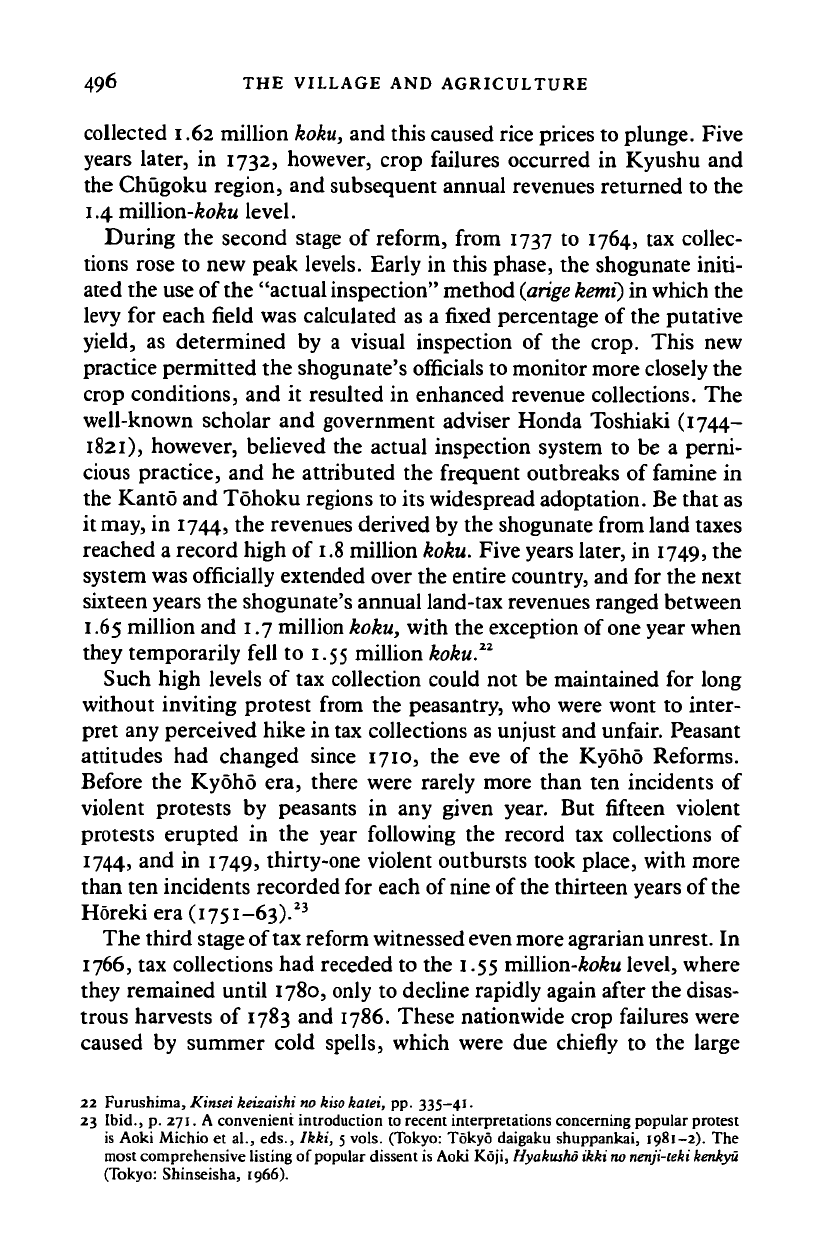
496 THE VILLAGE AND AGRICULTURE
collected 1.62 million
koku,
and this caused rice prices to plunge. Five
years later, in 1732, however, crop failures occurred in Kyushu and
the Chugoku region, and subsequent annual revenues returned to the
1.4
miWion-koku
level.
During the second stage of reform, from 1737 to 1764, tax collec-
tions rose to new peak levels. Early in this phase, the shogunate initi-
ated the use of the "actual inspection" method
(arige kemi)
in which the
levy for each field was calculated as a fixed percentage of the putative
yield, as determined by a visual inspection of the crop. This new
practice permitted the shogunate's officials to monitor more closely the
crop conditions, and it resulted in enhanced revenue collections. The
well-known scholar and government adviser Honda Toshiaki (1744-
1821),
however, believed the actual inspection system to be a perni-
cious practice, and he attributed the frequent outbreaks of famine in
the Kan to and Tohoku regions to its widespread adoptation. Be that as
it
may,
in 1744, the revenues derived by the shogunate from land taxes
reached a record high of 1.8 million
koku.
Five years later, in 1749, the
system was officially extended over the entire country, and for the next
sixteen years the shogunate's annual land-tax revenues ranged between
1.65 million and 1.7 million koku, with the exception of one year when
they temporarily fell to 1.55 million koku.
12
Such high levels of tax collection could not be maintained for long
without inviting protest from the peasantry, who were wont to inter-
pret any perceived hike in tax collections as unjust and unfair. Peasant
attitudes had changed since 1710, the eve of the Kyoho Reforms.
Before the Kyoho era, there were rarely more than ten incidents of
violent protests by peasants in any given year. But fifteen violent
protests erupted in the year following the record tax collections of
1744,
and in 1749, thirty-one violent outbursts took place, with more
than ten incidents recorded for each of nine of
the
thirteen years of the
Horeki era (1751-63).
23
The third stage of tax reform witnessed even more agrarian unrest. In
1766,
tax collections had receded to the 1.55 million-fco&K level, where
they remained until 1780, only to decline rapidly again after the disas-
trous harvests of 1783 and 1786. These nationwide crop failures were
caused by summer cold spells, which were due chiefly to the large
22 Furushima,
Kinsei keizaishi no
kisokatei,
pp.
335-41.
23 Ibid., p. 271. A convenient introduction to recent interpretations concerning popular protest
is Aoki Michio et al., eds., Ikki,
5
vols. (Tokyo: Tokyo daigaku shuppankai, 1981-2). The
most comprehensive listing of popular dissent is Aoki Koji,
Hyakusho ikki no nenji-teki kenkyu
(Tokyo: Shinseisha, 1966).
Cambridge Histories Online © Cambridge University Press, 2008
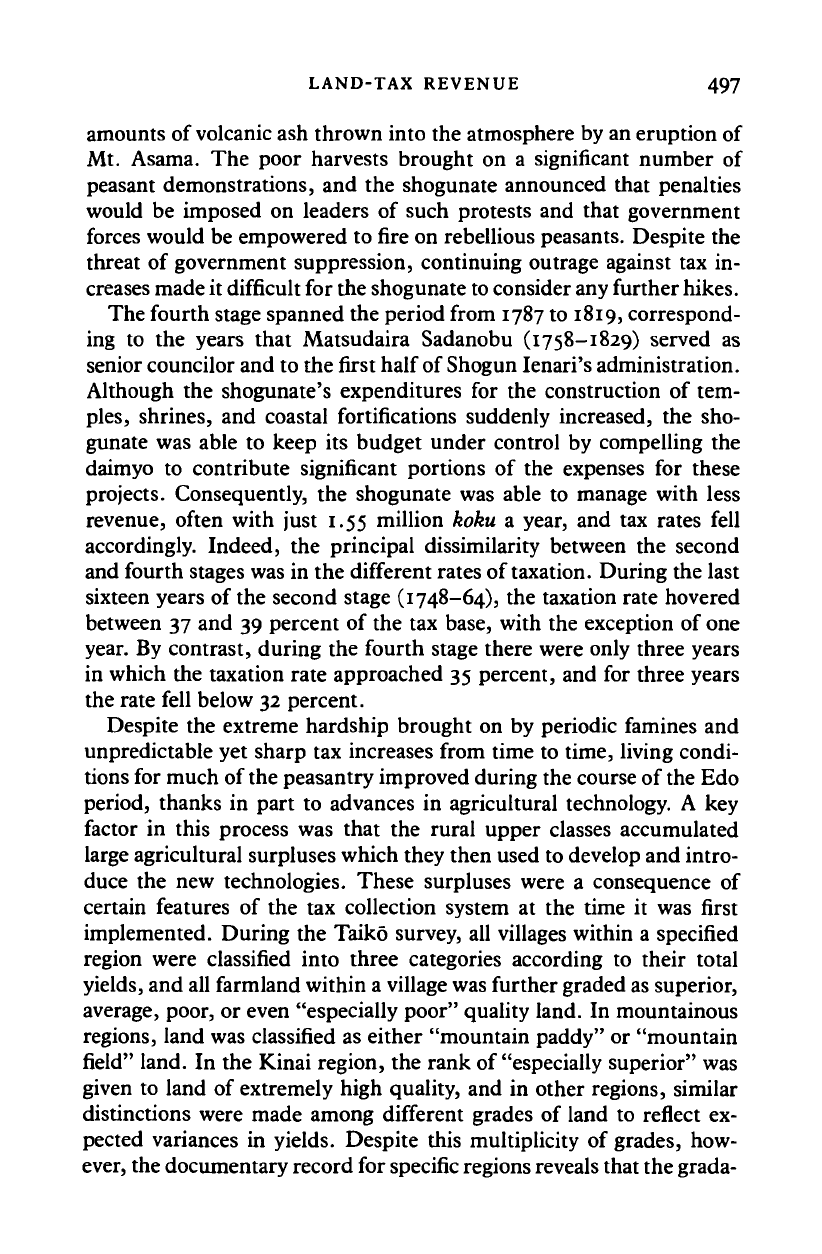
LAND-TAX REVENUE 497
amounts of volcanic ash thrown into the atmosphere by an eruption of
Mt. Asama. The poor harvests brought on a significant number of
peasant demonstrations, and the shogunate announced that penalties
would be imposed on leaders of such protests and that government
forces would be empowered to fire on rebellious peasants. Despite the
threat of government suppression, continuing outrage against tax in-
creases made it difficult for the shogunate to consider any further hikes.
The fourth stage spanned the period from 1787 to
1819,
correspond-
ing to the years that Matsudaira Sadanobu (1758-1829) served as
senior councilor and to the first half of Shogun Ienari's administration.
Although the shogunate's expenditures for the construction of tem-
ples,
shrines, and coastal fortifications suddenly increased, the sho-
gunate was able to keep its budget under control by compelling the
daimyo to contribute significant portions of the expenses for these
projects. Consequently, the shogunate was able to manage with less
revenue, often with just 1.55 million koku a year, and tax rates fell
accordingly. Indeed, the principal dissimilarity between the second
and fourth stages was in the different rates of
taxation.
During the last
sixteen years of the second stage (1748-64), the taxation rate hovered
between 37 and 39 percent of the tax base, with the exception of one
year. By contrast, during the fourth stage there were only three years
in which the taxation rate approached 35 percent, and for three years
the rate fell below 32 percent.
Despite the extreme hardship brought on by periodic famines and
unpredictable yet sharp tax increases from time to time, living condi-
tions for much of the peasantry improved during the course of
the
Edo
period, thanks in part to advances in agricultural technology. A key
factor in this process was that the rural upper classes accumulated
large agricultural surpluses which they then used to develop and intro-
duce the new technologies. These surpluses were a consequence of
certain features of the tax collection system at the time it was first
implemented. During the Taiko survey, all villages within a specified
region were classified into three categories according to their total
yields, and all farmland within a village was further graded as superior,
average, poor, or even "especially poor" quality land. In mountainous
regions, land was classified as either "mountain paddy" or "mountain
field" land. In the Kinai region, the rank of "especially superior" was
given to land of extremely high quality, and in other regions, similar
distinctions were made among different grades of land to reflect ex-
pected variances in yields. Despite this multiplicity of grades, how-
ever, the documentary record for specific regions reveals that the grada-
Cambridge Histories Online © Cambridge University Press, 2008
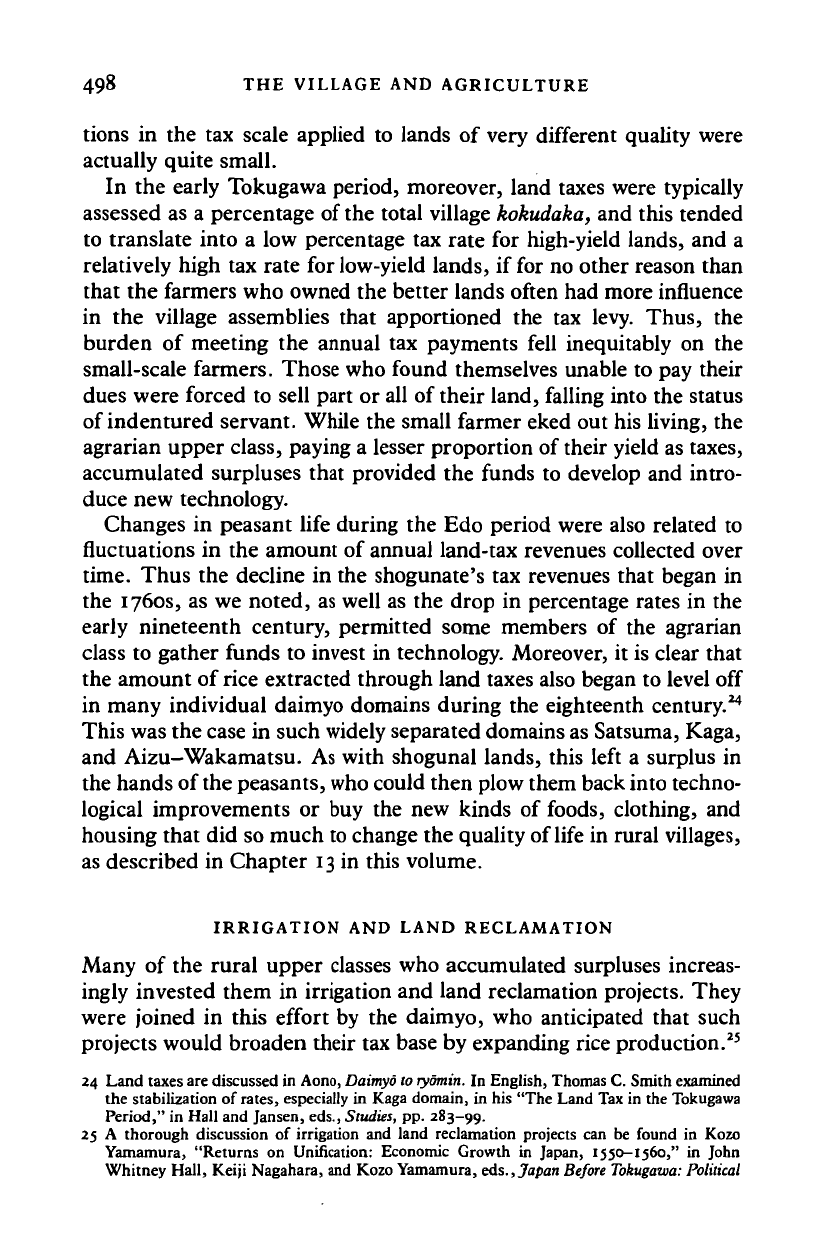
498 THE VILLAGE AND AGRICULTURE
tions in the tax scale applied to lands of very different quality were
actually quite small.
In the early Tokugawa period, moreover, land taxes were typically
assessed as a percentage of the total village
kokudaka,
and this tended
to translate into a low percentage tax rate for high-yield lands, and a
relatively high tax rate for low-yield lands, if for no other reason than
that the farmers who owned the better lands often had more influence
in the village assemblies that apportioned the tax levy. Thus, the
burden of meeting the annual tax payments fell inequitably on the
small-scale farmers. Those who found themselves unable to pay their
dues were forced to sell part or all of their land, falling into the status
of indentured servant. While the small farmer eked out his living, the
agrarian upper class, paying a lesser proportion of their yield as taxes,
accumulated surpluses that provided the funds to develop and intro-
duce new technology.
Changes in peasant life during the Edo period were also related to
fluctuations in the amount of annual land-tax revenues collected over
time.
Thus the decline in the shogunate's tax revenues that began in
the 1760s, as we noted, as well as the drop in percentage rates in the
early nineteenth century, permitted some members of the agrarian
class to gather funds to invest in technology. Moreover, it is clear that
the amount of rice extracted through land taxes also began to level off
in many individual daimyo domains during the eighteenth century.
24
This was the case in such widely separated domains as Satsuma, Kaga,
and Aizu-Wakamatsu. As with shogunal lands, this left a surplus in
the hands of the peasants, who could then plow them back into techno-
logical improvements or buy the new kinds of foods, clothing, and
housing that did so much to change the quality of life in rural villages,
as described in Chapter
13
in this volume.
IRRIGATION AND LAND RECLAMATION
Many of the rural upper classes who accumulated surpluses increas-
ingly invested them in irrigation and land reclamation projects. They
were joined in this effort by the daimyo, who anticipated that such
projects would broaden their tax base by expanding rice production.
25
24 Land taxes are discussed in Aono, Daimyo to
ryomin.
In English, Thomas C. Smith examined
the stabilization of rates, especially in Kaga domain, in his "The Land Tax in the Tokugawa
Period," in Hall and Jansen, eds., Studies, pp. 283-99.
25 A thorough discussion of irrigation and land reclamation projects can be found in Kozo
Yamamura, "Returns on Unification: Economic Growth in Japan, 1550-1560," in John
Whitney Hall, Keiji Nagahara, and Kozo Yamamura, eds., Japan Before
Tokugawa:
Political
Cambridge Histories Online © Cambridge University Press, 2008
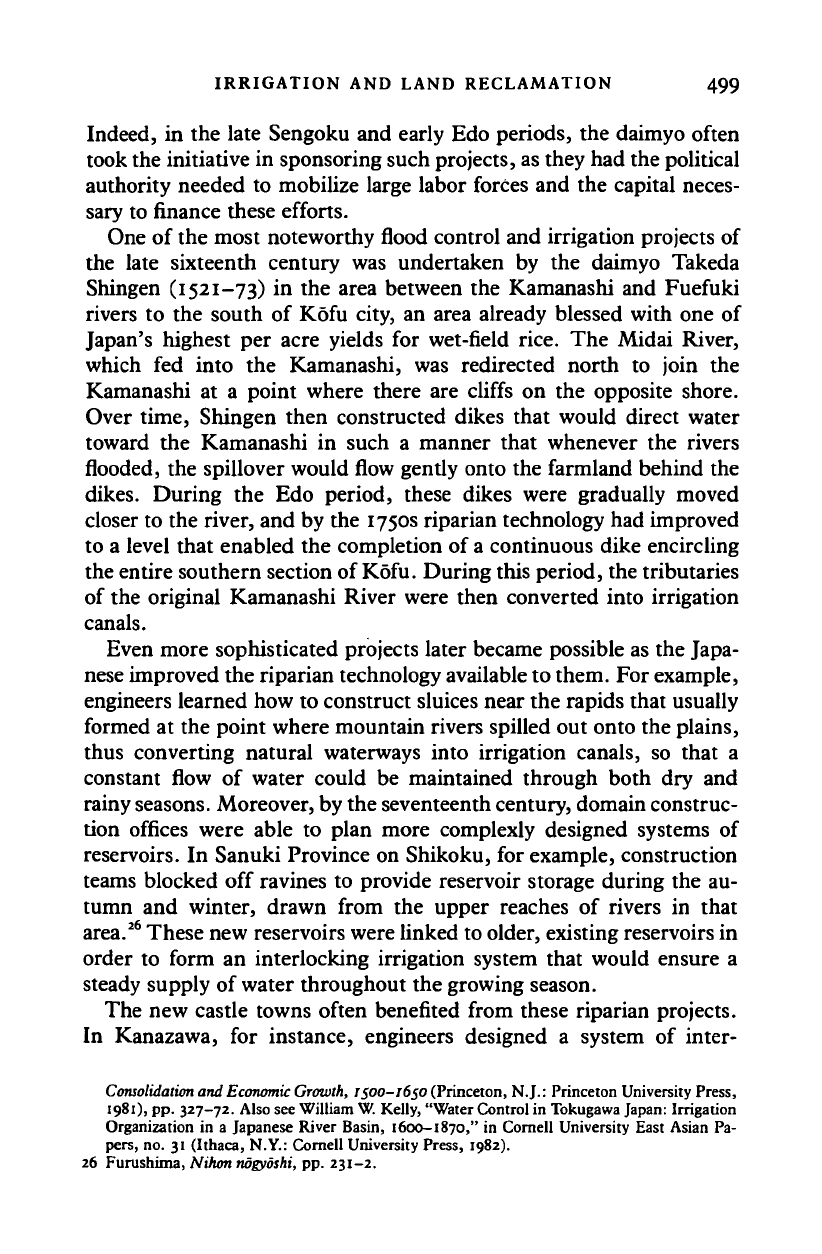
IRRIGATION AND LAND RECLAMATION 499
Indeed, in the late Sengoku and early Edo periods, the daimyo often
took the initiative in sponsoring such projects, as they had the political
authority needed to mobilize large labor forces and the capital neces-
sary to finance these efforts.
One of the most noteworthy flood control and irrigation projects of
the late sixteenth century was undertaken by the daimyo Takeda
Shingen (1521-73) in the area between the Kamanashi and Fuefuki
rivers to the south of Kofu city, an area already blessed with one of
Japan's highest per acre yields for wet-field rice. The Midai River,
which fed into the Kamanashi, was redirected north to join the
Kamanashi at a point where there are cliffs on the opposite shore.
Over time, Shingen then constructed dikes that would direct water
toward the Kamanashi in such a manner that whenever the rivers
flooded, the spillover would flow gently onto the farmland behind the
dikes.
During the Edo period, these dikes were gradually moved
closer to the river, and by the 1750s riparian technology had improved
to a level that enabled the completion of
a
continuous dike encircling
the entire southern section of Kofu. During this period, the tributaries
of the original Kamanashi River were then converted into irrigation
canals.
Even more sophisticated projects later became possible as the Japa-
nese improved the riparian technology available to them. For example,
engineers learned how to construct sluices near the rapids that usually
formed at the point where mountain rivers spilled out onto the plains,
thus converting natural waterways into irrigation canals, so that a
constant flow of water could be maintained through both dry and
rainy
seasons.
Moreover, by the seventeenth century, domain construc-
tion offices were able to plan more complexly designed systems of
reservoirs. In Sanuki Province on Shikoku, for example, construction
teams blocked off ravines to provide reservoir storage during the au-
tumn and winter, drawn from the upper reaches of rivers in that
area.
26
These new reservoirs were linked to older, existing reservoirs in
order to form an interlocking irrigation system that would ensure a
steady supply of water throughout the growing season.
The new castle towns often benefited from these riparian projects.
In Kanazawa, for instance, engineers designed a system of inter-
Consolidation
and
Economic
Growth, 1500-1650 (Princeton, N.J.: Princeton University Press,
1981),
pp. 327-72. Also see William W. Kelly, "Water Control in Tokugawa Japan: Irrigation
Organization in a Japanese River Basin, 1600-1870," in Cornell University East Asian Pa-
pers,
no. 31 (Ithaca, N.Y.: Cornell University Press, 1982).
26 Furushima, Nihon
ndgyoshi,
pp. 231-2.
Cambridge Histories Online © Cambridge University Press, 2008
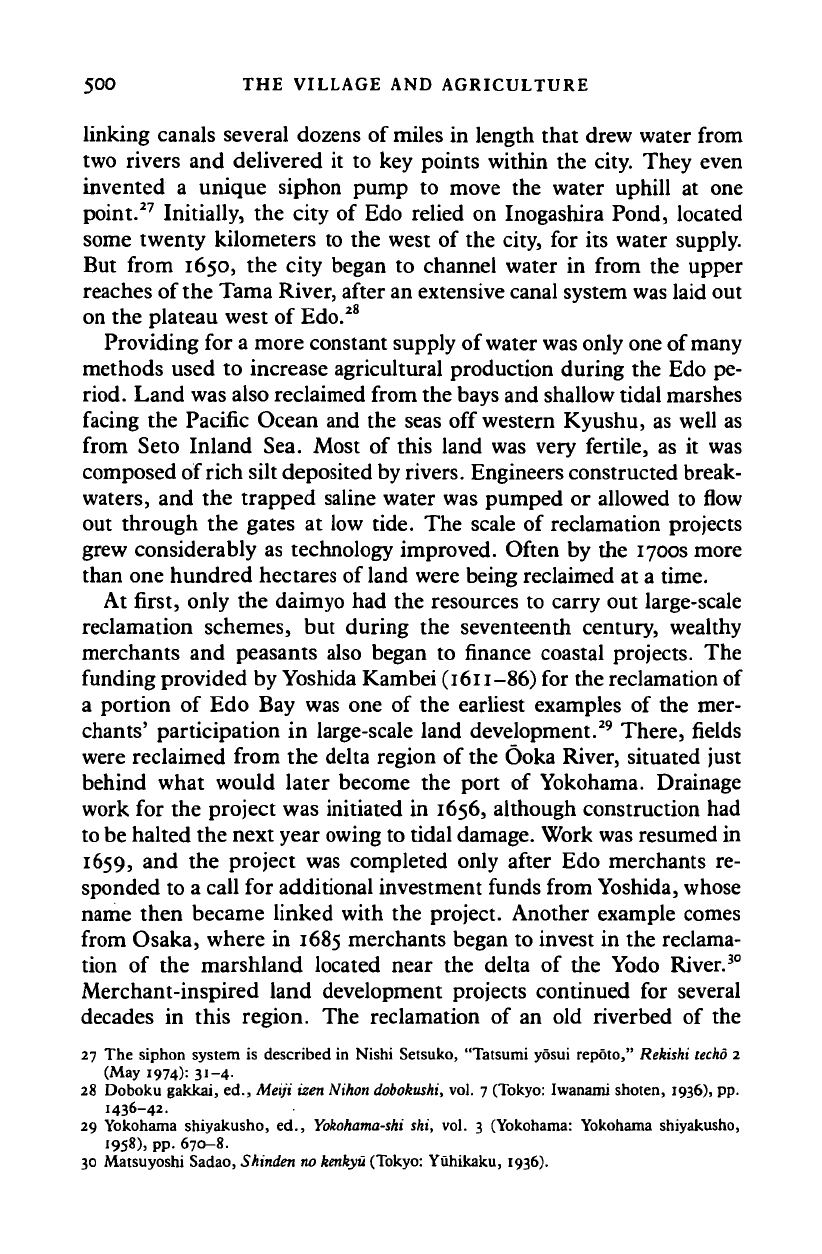
500 THE VILLAGE AND AGRICULTURE
linking canals several dozens of miles in length that drew water from
two rivers and delivered it to key points within the city. They even
invented a unique siphon pump to move the water uphill at one
point.
27
Initially, the city of Edo relied on Inogashira Pond, located
some twenty kilometers to the west of the city, for its water supply.
But from 1650, the city began to channel water in from the upper
reaches of the Tama River, after an extensive canal system was laid out
on the plateau west of Edo.
28
Providing for a more constant supply of water was only one of many
methods used to increase agricultural production during the Edo pe-
riod. Land was also reclaimed from the bays and shallow tidal marshes
facing the Pacific Ocean and the seas off western Kyushu, as well as
from Seto Inland Sea. Most of this land was very fertile, as it was
composed of rich silt deposited by
rivers.
Engineers constructed break-
waters, and the trapped saline water was pumped or allowed to flow
out through the gates at low tide. The scale of reclamation projects
grew considerably as technology improved. Often by the 1700s more
than one hundred hectares of land were being reclaimed at a time.
At first, only the daimyo had the resources to carry out large-scale
reclamation schemes, but during the seventeenth century, wealthy
merchants and peasants also began to finance coastal projects. The
funding provided by Yoshida Kambei (1611-86) for the reclamation of
a portion of Edo Bay was one of the earliest examples of the mer-
chants' participation in large-scale land development.
29
There, fields
were reclaimed from the delta region of the Ooka River, situated just
behind what would later become the port of Yokohama. Drainage
work for the project was initiated in 1656, although construction had
to be halted the next year owing to tidal damage. Work was resumed in
1659,
and the project was completed only after Edo merchants re-
sponded to a call for additional investment funds from Yoshida, whose
name then became linked with the project. Another example comes
from Osaka, where in 1685 merchants began to invest in the reclama-
tion of the marshland located near the delta of the Yodo River.
30
Merchant-inspired land development projects continued for several
decades in this region. The reclamation of an old riverbed of the
27 The siphon system is described in Nishi Setsuko, "Tatsumi yosui repoto," Rekishi techo 2
(May 1974): 31-4.
28 Doboku gakkai, ed., Meiji izen Nihon
dobokushi,
vol. 7 (Tokyo: Iwanami shoten, 1936), pp.
1436-42.
29 Yokohama shiyakusho, ed.,
Yokohama-shi
shi, vol. 3 (Yokohama: Yokohama shiyakusho,
1958),
PP- 670-8.
30 Matsuyoshi Sadao, Shinden no
kenkyu
(Tokyo: Yuhikaku, 1936).
Cambridge Histories Online © Cambridge University Press, 2008
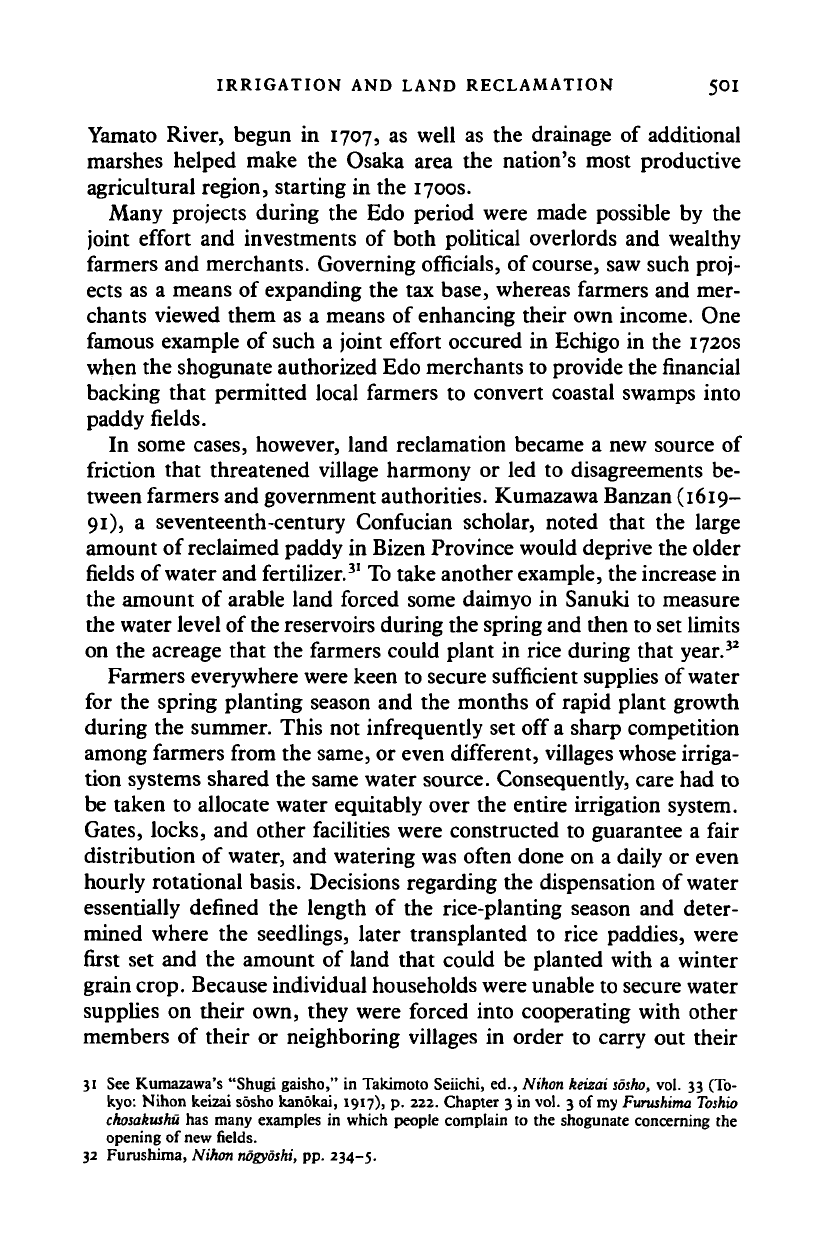
IRRIGATION AND LAND RECLAMATION 50I
Yamato River, begun in 1707, as well as the drainage of additional
marshes helped make the Osaka area the nation's most productive
agricultural region, starting in the 1700s.
Many projects during the Edo period were made possible by the
joint effort and investments of both political overlords and wealthy
farmers and merchants. Governing officials, of
course,
saw such
proj-
ects as a means of expanding the tax base, whereas farmers and mer-
chants viewed them as a means of enhancing their own income. One
famous example of such a joint effort occured in Echigo in the 1720s
when the shogunate authorized Edo merchants to provide the financial
backing that permitted local farmers to convert coastal swamps into
paddy fields.
In some cases, however, land reclamation became a new source of
friction that threatened village harmony or led to disagreements be-
tween farmers and government authorities. Kumazawa Banzan (1619-
91),
a seventeenth-century Confucian scholar, noted that the large
amount of reclaimed paddy in Bizen Province would deprive the older
fields of water and fertilizer.
31
To take another example, the increase in
the amount of arable land forced some daimyo in Sanuki to measure
the water level of the reservoirs during the spring and then to set limits
on the acreage that the farmers could plant in rice during that year.
32
Farmers everywhere were keen to secure sufficient supplies of water
for the spring planting season and the months of rapid plant growth
during the summer. This not infrequently set off
a
sharp competition
among farmers from the same, or even different, villages whose irriga-
tion systems shared the same water source. Consequently, care had to
be taken to allocate water equitably over the entire irrigation system.
Gates,
locks, and other facilities were constructed to guarantee a fair
distribution of water, and watering was often done on a daily or even
hourly rotational basis. Decisions regarding the dispensation of water
essentially defined the length of the rice-planting season and deter-
mined where the seedlings, later transplanted to rice paddies, were
first set and the amount of land that could be planted with a winter
grain crop. Because individual households were unable to secure water
supplies on their own, they were forced into cooperating with other
members of their or neighboring villages in order to carry out their
31 See Kumazawa's "Shugi gaisho," in Takimoto Seiichi, ed., Nikon keizai
sdsho,
vol. 33 (To-
kyo:
Nihon keizai sdsho kanokai, 1917), p. 222. Chapter 3 in vol. 3 of my
Furushima Toshio
chosakushu
has many examples in which people complain to the shogunate concerning the
opening of new fields.
32 Furushima, Nihon
nogyoshi,
pp. 234-5.
Cambridge Histories Online © Cambridge University Press, 2008
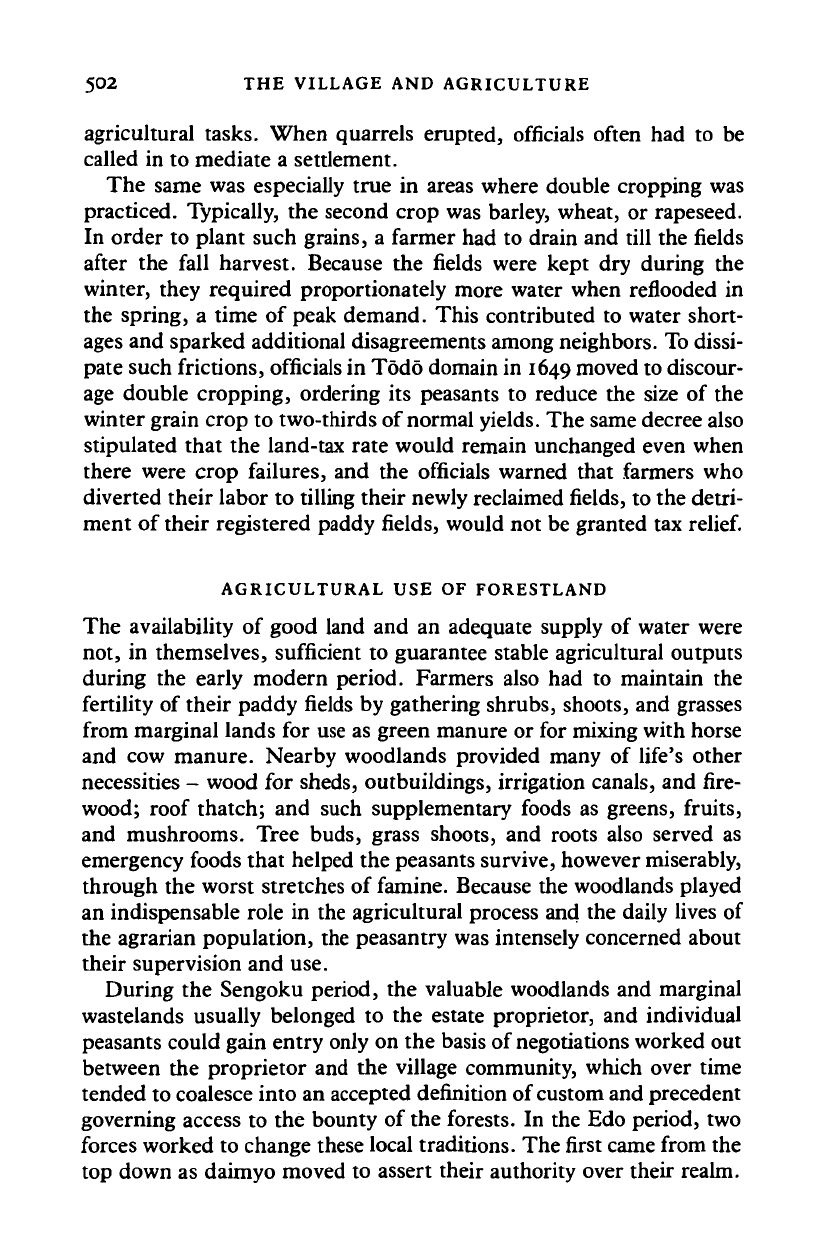
502 THE VILLAGE AND AGRICULTURE
agricultural tasks. When quarrels erupted, officials often had to be
called in to mediate a settlement.
The same was especially true in areas where double cropping was
practiced. Typically, the second crop was barley, wheat, or rapeseed.
In order to plant such grains, a farmer had to drain and till the fields
after the fall harvest. Because the fields were kept dry during the
winter, they required proportionately more water when reflooded in
the spring, a time of peak demand. This contributed to water short-
ages and sparked additional disagreements among neighbors. To dissi-
pate such frictions, officials in Todo domain in 1649 moved to discour-
age double cropping, ordering its peasants to reduce the size of the
winter grain crop to two-thirds of normal yields. The same decree also
stipulated that the land-tax rate would remain unchanged even when
there were crop failures, and the officials warned that farmers who
diverted their labor to tilling their newly reclaimed fields, to the detri-
ment of their registered paddy fields, would not be granted tax
relief.
AGRICULTURAL USE OF FORESTLAND
The availability of good land and an adequate supply of water were
not, in themselves, sufficient to guarantee stable agricultural outputs
during the early modern period. Farmers also had to maintain the
fertility of their paddy fields by gathering shrubs, shoots, and grasses
from marginal lands for use as green manure or for mixing with horse
and cow manure. Nearby woodlands provided many of life's other
necessities - wood for sheds, outbuildings, irrigation canals, and fire-
wood; roof thatch; and such supplementary foods as greens, fruits,
and mushrooms. Tree buds, grass shoots, and roots also served as
emergency foods that helped the peasants survive, however miserably,
through the worst stretches of famine. Because the woodlands played
an indispensable role in the agricultural process and the daily lives of
the agrarian population, the peasantry was intensely concerned about
their supervision and use.
During the Sengoku period, the valuable woodlands and marginal
wastelands usually belonged to the estate proprietor, and individual
peasants could gain entry only on the basis of negotiations worked out
between the proprietor and the village community, which over time
tended to coalesce into an accepted definition of custom and precedent
governing access to the bounty of the forests. In the Edo period, two
forces worked to change these local traditions. The first came from the
top down as daimyo moved to assert their authority over their realm.
Cambridge Histories Online © Cambridge University Press, 2008

AGRICULTURAL USE OF FORESTLAND 503
From the late sixteenth century, daimyo needed building materials in
order to construct their castle towns. Even later, demand remained
high as the country's cities were ravaged periodically by fires. Conse-
quently the daimyo regulated the felling of trees that could be used for
construction materials. At first, they tended to declare the dense for-
ests in remote mountains that contained the largest trees as being off
limits to the farmers, though the lords still permitted villagers access
to the smaller woodlands that surrounded the agricultural plots. Later,
many daimyo barred the peasants from cutting zelkova, cedar, cy-
press,
fir, hemlock, and other prime timber on these smaller wood-
lands.
In time, the shogunate and most daimyo designated all timber
stands as "the lord's forest" and strictly prohibited any unauthorized
cutting of trees.
33
The second force for change came from inside the village commu-
nity
itself.
In the medieval period, the local conventions worked out
with proprietors had typically provided only for a village's elite, land-
holding families to have access to the forests, whereas the commoner
farmers usually could enter the forest only by virtue of their estab-
lished relationships with the elites. In time, however, the commoner
farmers became inclined to consider such privileges as rights, and they
came to view nearby forestland as communal property from which
they could gather firewood and materials for building and for aging
into fertilizer. In many places by the mid-seventeenth century, villag-
ers were demanding that the forests be opened to the whole commu-
nity. Government officials were usually invited to mediate such dis-
putes,
and the typical solution was to reserve a small portion of the
forestland for the person claiming ownership and to open most of the
remaining land for communal use.
Although the documentation for this evolution of rights to for-
estland is sketchy, it appears that as elite control broke down, the use
of communal forests came to be regulated by the village covenant,
which guaranteed equal access to the forests.
34
Infractions of the vil-
lage covenant could be punished by the withdrawal of such rights, and
the eyes of the village youth association
(wakamonogumi)
enforced
compliance. The covenant determined the opening day and length of
the periods during which entry into the forests would be allowed. The
first day of each gathering season was usually referred to as the day of
"opening the gates to the mountains." After inspecting the growth of
33 Forestry policy is the subject of Conrad Totman, The Origins of Japan's
Modern
Forests:
The
Case of Akita (Honolulu: University of Hawaii Press, 1985).
34 Furushima, Kinsei keizaishi no kiso katei, pp. 186-94.
Cambridge Histories Online © Cambridge University Press, 2008

504 THE VILLAGE AND AGRICULTURE
rice seedlings and meadow grasses, the village officials would desig-
nate a day during which grass used for mulch could be cut, usually two
or three days before the seedlings were transplanted to the paddies.
There were separate opening days and periods for collecting fodder
that would be used for farm animals, for gathering the hay spread on
barn floors during the winter, and for cutting firewood and roof
thatch.
Daimyo and village alike enforced other restrictions so as to protect
the forests' resources. Most daimyo permitted peasants to use only
sickles and scythes when in the woodlands so that they would not
damage large, valuable trees. Frequently, village covenants included a
provision prohibiting the sale of harvested grasses, especially to peas-
ants from other villages. Similarly, a farmer's consumption of forest
products was limited to the amount of grass required to fertilize his
paddy fields and the amount of hay that had to be mixed with the
manure in his compost pits. Equal access did not mean equal division
of forest and meadow products among all households. Instead, the
yield from the meadows and forests was typically divided among farm-
ers according to the size of a farmer's landholdings and the number of
people in his family.
This system underwent additional changes during the latter half of
the Tokugawa period. A farmer's yearly take from the woodlands came
to be perceived as a right held by every farming household, and these
allotments began to be bartered and sold. Some households were as-
signed plots in woodlands, initially for limited periods of time. Such
assignments gradually became permanent, and individual households
began to ignore village or communal claims to the forests and wood-
lands.
Some farmers planted thickets in order to sell the yield as
firewood, and others produced and marketed charcoal. Forestland was
cleared and converted into paddy land, and meadowland was forested
so that farmers could sell trees for use as lumber. This privatization
and commercialization of communal lands became especially prevalent
after 1800.
TECHNOLOGY AND COMMERCIAL AGRICULTURE
The previous sections have examined how several aspects of agricul-
tural life changed over the seventeenth and eighteenth centuries. It is
now possible to take a more comprehensive view of the evolving agri-
cultural community and to elaborate on the relationship between the
transformations in village life and the changes in the mode of agricul-
Cambridge Histories Online © Cambridge University Press, 2008
